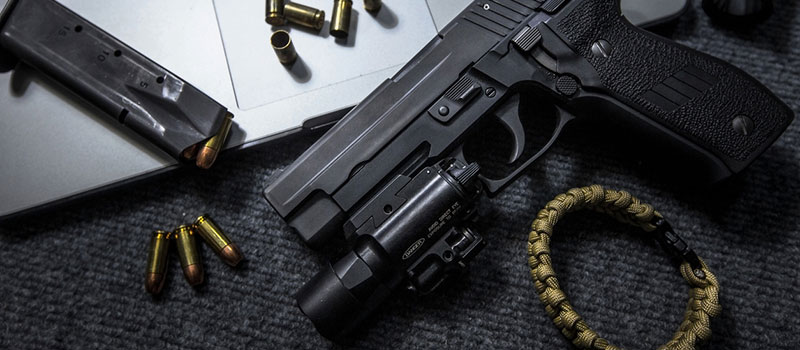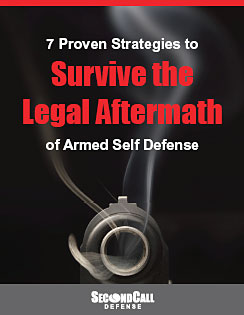Out of the Dark Ages: Low-Light/No-Light Upgrades for Your Defensive Pistol
by
Keith Coniglio
The importance of identifying potential threats and engaging them accurately doesn’t fade when the sun goes down. Just a few simple additions to your defensive pistol can help you see what you might otherwise be missing.
Few things dispel misconceptions quite like experience. Growing up in the “non-permissive environment” of NYC, circa 1970s-1990s, my handgun knowledge consisted mostly of lore and old-school biases. I was convinced that “technological advancement” was synonymous with “frivolous gadgetry” and merely meant more things to go wrong. I eschewed anything fancier than adjustable iron sights, and all but sneered at anything that required — gasp! — batteries.
I eventually moved to Colorado, a state that recognized gun ownership as a right rather than a privilege, and I was suddenly free to put my theoretical knowledge to the test. Shooting sessions in the light of day were exhilarating — but low- and no-light conditions were humbling. It didn’t take long to admit that perhaps 1957 wasn’t the pinnacle of firearm technology after all, and that the tool which may be called up to save my life just might benefit from a few minor upgrades.
Night sights
If you’ve had any pistol instruction at all, you’re probably still hearing “front sight, front sight, front sight” echoing in your head. However, as my introduction to low-light shooting drills taught me, it’s hard to adhere to that mantra when your sights are all but invisible. Dim conditions such as outdoors at dusk or poorly lit hallways or streets can make a front sight blade difficult to pick up, especially under stress. A glowing dot, however, stands out in stark contrast for a quick sight picture.
Night sights require no external power source and are commonly illuminated by a small tritium insert, lasting many years. They offer no noticeable illumination during daylight hours but are brightly visible in darkness. Several manufacturers also produce sights with brightly-colored fiber-optic inserts, magnifying the ambient lighting conditions and make the sight easier to see. Unlike tritium, these inserts won’t dim over time, but are also less useful towards more complete darkness.
While pistols equipped with night sights are more commonly available than in decades past (and well worth a modest additional cost) they aren’t a standard feature. Luckily, companies such as Trijicon, Meprolight, and AmeriGlo sell aftermarket sights, allowing you to replace a fading factory set or to retrofit a handgun equipped with standard sights. Prices vary both by manufacturer and the make/model of intended firearm, but generally run from $40 to $150.
Weapon-mounted lights
Immersed in “old-school” methods, I’d grown up reasonably secure that any nighttime target illumination could easily be done with a flashlight held in my support hand. First-hand experience once again showed me the shortcomings of this method. Attempting to perform a reload — revolver or semi-auto — was awkward; clearing a semi-automatic’s jam was even worse; envisioning an injury to my shooting hand (a not-uncommon occurrence during a violent encounter) was downright sobering. Parenthood underscored the lesson even further as I pictured trying to manage my clinging toddler while needing both hands to illuminate an intruder.
Enter
the weapon-mounted light. Compact and lightweight, these powerful lights mount beneath the muzzle of your handgun and provide you the ability to clearly identify a potential threat — or avoid tragically misidentifying one — without tying up your support hand. The lights are most frequently activated by a pressure switch mounted to your handgun’s grip or by a paddle on the rear of the unit, allowing you to maintain a proper shooting grip on your pistol. Most models will allow either a quick flash or a steady-on beam, powerful enough to easily illuminate both whatever your muzzle is covering and the area surrounding it (this also provides the additional feature of impairing an attacker’s night vision). While some light-and-laser units can run several hundred dollars, most quality pistol-mounted white lights can be found in the $75-100 range.
[A very serious word of warning — when mounted to a firearm, a weapon light is NOT a flashlight. Whatever you are illuminating will also have your pistol’s muzzle pointed directly at it. Safety rules always apply!]
These tactical lights are most commonly mounted by means of rails milled into the pistol’s frame. While rails have become virtually standard in today’s run of full-sized and compact pistols, they are generally absent from most ultra-compact pistols and from just about anything made before the late 1990s. If you have such a pistol, though, you’re not out of luck! Manufacturers such as Streamlight and Surefire have also developed lights that clamp directly to the trigger guard, and other companies have bridged the gap with guard-mounted rail systems.
Unlike the simplicity of installing night sights, deciding to add a mounted light requires some additional consideration. Your current holster is unlikely to fit the new configuration, especially if it’s made of molded leather or kydex. Likewise, any replacement holster molded to the shape of your new light would be useless if a different model is purchased down the road. And, while some models use standard AA batteries, most rely on specialized lithium cells such as CR2 or CR123A. These are still widely available but not as common — they may be more difficult to come by depending on your location — and are generally more expensive.
Remember that dogmatic faith in technology can be as dangerous as dogmatic rejection of it. Test your light! Make sure it not only throws light but continues to function as expected while under recoil at the range. Learn the cues that indicate a dying battery and replace it before the point of failure. Also remember that this isn’t merely a new “part,” it’s a new skill. Regularly practice — with an unloaded gun — activating the light in its various modes to ensure that you can do so when desired and without pressing the trigger by mistake.
A small investment of money can pay huge dividends when the light begins to fade. Whether aiding in accuracy against deadly threats and avoiding tragic mistakes in the dark, night sights and weapon-mounted lights have proven themselves to be reliable and useful tools — far from being the “frivolous gadgets” I considered them, back when I lived in the Dark Ages.
Keith Coniglio is a father, software tester, NRA-certified pistol instructor, and devoted Second Amendment advocate. He is also the editor-in-chief of Descendants of Liberty Press, a site dedicated to rekindling Americans’ passion for – and defense of – their Constitutional rights and personal liberty.


